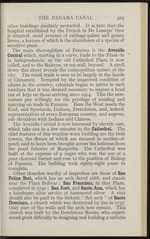| 1 |
 |
“...Caribbean Sea, nestles at the foot of
lofty mountains. Its spacious harbour, like that of
Havana, is almost land-locked, the promontory protect-
ing it having also a Morro Castle of great antiquity.
It was in this harbour that Admiral Cervera lay from
May 19th to July 3rd, 1898, when his vessels steamed
out to destruction, and it was the bottle-necked entrance
which Lieut. Hobson courageously endeavoured to block
by sinking the Merrimac.
Overlooking the Bay, in front of the Town Hall, on the
Avenida de Loraine (formerly de Michaelsen), stands
a pylon of pink marble with a bronze bust upon it of the
English Naval Officer Commander, afterwards Rear-
Admiral, Sir Lambton Loraine (bom Nov. 17th, 1838,
died May 17th, 1917), who, while in command of H.M.S.
Niobe in November, 1873, saved the lives of over one...”
|
|
| 2 |
 |
“...lawns, a feature of which is the abundance of a species of
sensitive plant.
The main thoroughfare of Panama is the Avenida
Central which, starting in a curve, leads to the Plaza de
la Independencia, as the old Cathedral Plaza is now
called, and to the Malecon, or sea-wall, beyond. A stroll
down this street reveals the cosmopolitan nature of the
city. The retail trade is seen to be largely in the hands
of Chinamen. Tempted by the improved condition of
affairs in the country, celestials began to arrive in such
numbers that it was deemed necessary to impose a head
tax of $250 on those arriving since 1904. This the new-
comers pay willingly for the privilege of residing and
carrying on trade in Panama. Here the West meets the
East, and Spaniards, Italians, Frenchmen, and, indeed,
representatives of every European country, and negroes,
rub shoulders with Indians and Chinese.
The Avenida Central is now traversed by electric cars,
which take one in a few minutes to the Cathedral. The
chief features...”
|
|
| 3 |
 |
“...Hall, which
he had designed. They declared that otherwise the
floor would collapse; so Wren erected the columns.
But he purposely made them too short, and to this day
the floor stands as he made it, and there is a space
between the ceiling and the columns.
Facing the Cathedral are several public buildings, and
the Episcopal Palace and old Government Palace. Among
the new buildings one of the most noteworthy in the
neighbourhood is the handsome Palacio Municipal or City
At the lower end of the Avenida is a substantial group
of Government Buildings, at the back of which is the
handsome Teatro Nacional. This is certainly one of the
finest buildings of the kind in this part of the world.
The palatial Union Club, where the Prince of Wales was
entertained at a Ball on March 31st, 1920, overlooks the
harbour and bay.
The Malecon or sea-wall is a popular and fashionable
promenade. To the west of it is another Malecon—that
of Las Bovedas, under which are the old prisons. The
view from these sea-walls...”
|
|
